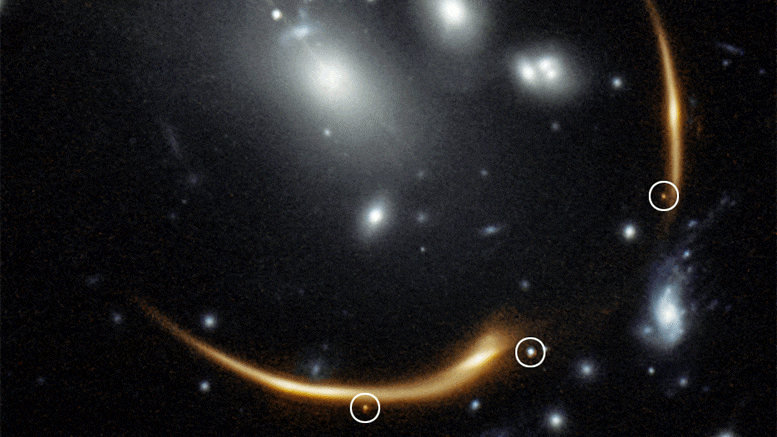
Three mirror images of Supernova Requiem were spotted by the Hubble Space Telescope scattered in an arc-like pattern across the cluster.
Three views of the same supernova appear in the 2016 image on the left, taken by the Hubble Space Telescope.
The distant supernova, named Requiem, is embedded in the giant galaxy cluster MACS J0138.
The cluster is so massive that its powerful gravity bends and magnifies the light from the supernova, located in a galaxy far behind it.
Called gravitational lensing, this phenomenon also splits the supernova’s light into multiple mirror images, highlighted by the white circles in the 2016 image.
The light from Supernova Requiem needed an estimated 10 billion years for its journey, based on the distance of its host galaxy.
The light that Hubble captured from the cluster, MACS J0138.0-2155, took about four billion years to reach Earth.
Now, looking far beyond the solar system, astronomers have added a solid prediction of an event happening deep in intergalactic space: an image of an exploding star, dubbed Supernova Requiem, which will appear around the year 2037.Three images of the supernova were first found from archival data taken in 2016 by NASA’s Hubble Space Telescope.
The multiple images are produced by the monster galaxy cluster’s powerful gravity, which distorts and magnifies the light from the supernova far behind it, an effect called gravitational lensing.First predicted by Albert Einstein, this effect is similar to a glass lens bending light to magnify the image of a distant object.
The three lensed supernova images, seen as tiny dots captured in a single Hubble snapshot, represent light from the explosive aftermath.This animation demonstrates how light from Supernova Requiem, which exploded about 10 billion years ago, was split into multiple images by a massive foreground cluster of galaxies.
The supernova’s light is traveling billions of light-years toward Earth when it runs into the hefty galaxy cluster.
The galactic grouping’s gravity magnifies, brightens, and splits the supernova’s light into multiple mages, which appeared in a 2016 Hubble Space Telescope snapshot.
The light that Hubble captured from the cluster, MACS J0138.0-2155, took about four billion years to reach Earth.The light from Supernova Requiem needed an estimated 10 billion years for its journey, based on the distance of its host galaxy.
Each magnified image takes a different route through the cluster and arrives at Earth at a different time, due, in part, to differences in the length of the pathways the supernova light followed.“Whenever some light passes near a very massive object, like a galaxy or galaxy cluster, the warping of space-time that Einstein’s theory of general relativity tells us is present for any mass, delays the travel of light around that mass,” Rodney said.In addition, the lensed supernova image predicted to appear in 2037 lags behind the other images of the same supernova because its light travels directly through the middle of the cluster, where the densest amount of dark matter resides.Brammer spotted the mirrored supernova images while analyzing distant galaxies magnified by massive foreground galaxy clusters as part of an ongoing Hubble program called REsolved QUIEscent Magnified Galaxies (REQUIEM).
“Each of the three objects was paired with a lensed image of a distant massive galaxy.
Immediately it suggested to me that it was not a distant galaxy but actually a transient source in this system that had faded from view in the 2019 images like a light bulb that had been flicked off.”.
Spotting lensed images of supernovae will become increasingly common in the next 20 years with the launch of NASA’s Nancy Grace Roman Space Telescope and the start of operations at the Vera C.Future telescopes such as NASA’s James Webb Space Telescope also could detect light from supernova Requiem at other epochs of the blast. The team’s results will appear on September 13 in the journal Nature Astronomy.The Hubble Space Telescope is a project of international cooperation between NASA and ESA (European Space Agency).The Space Telescope Science Institute (STScI) in Baltimore, Maryland, conducts Hubble science operations